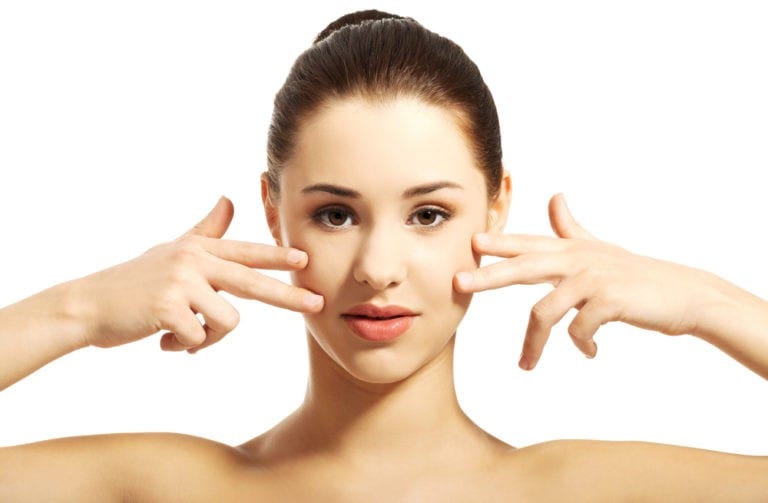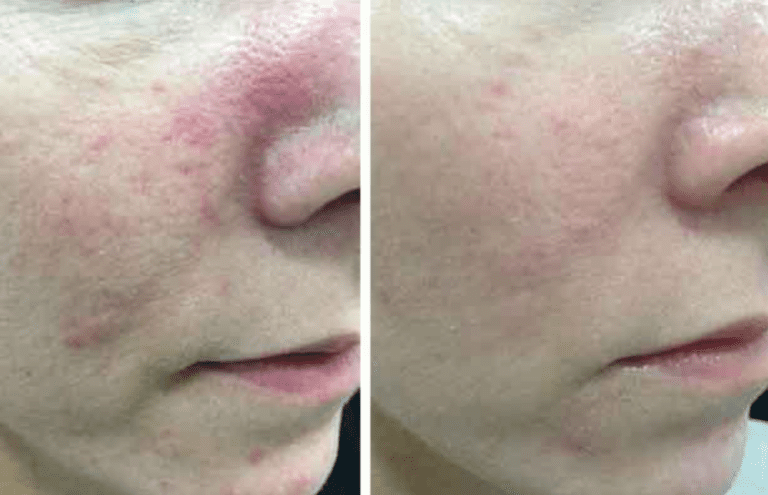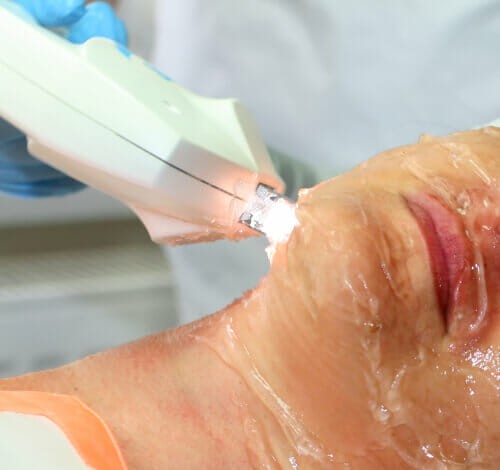

Skin Disorders
At VIDA Wellness and Beauty, we understand that it can be bothersome, embarrassing or downright frightening to discover a skin abnormality. Perhaps you have an ongoing skin disorder such as eczema that is uncomfortable and makes you feel self-conscious about your condition. Or, you may have recently noticed a new skin irregularity that looks scary. Whatever the case, the VIDA dermatologists in Tijuana can help.
In this video, Dr. De La Fuente talks about the treatment for one of the most common skin disorders Rosacea:
Skin Disorder Treatment in Mexico
We offer treatments for all disorders of the skin, hair and nails. Some of the common skin disorders that we treat are:
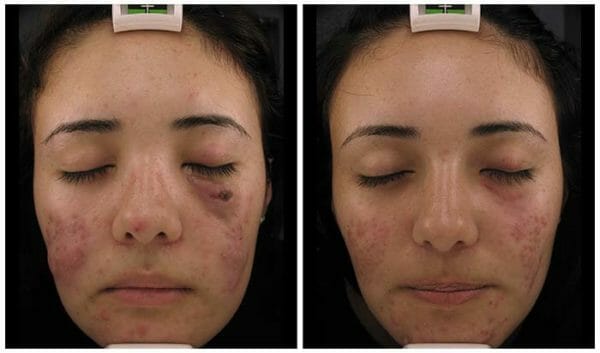

Acne treatment patient
Common Skin Disorders
Acne
Acne is a very common skin condition, which tends to present during adolescence. Acne affects up to 90% of people at some point in their lives and it can vary in severity. Acne is characterized by red pimples, which are usually found on the face, but can also develop on the chest and back. In severe cases, acne can cause irritation, redness and pain. This form of skin disorder is often linked to hormonal changes in the body, which affect the sebaceous glands, causing the body to produce excess oil. Acne is usually less common in adults, affecting around 3% of adults aged over 35 years old. Acne scarring is a common issue in adults who suffered from severe symptoms of acne during their teenage years. If you have scars on your face, chest or back from acne, it is possible to reduce the visibility of scarring using cutting-edge treatments.
Acne Keloidalis Nuchae
Acne keloidalis nuchae, also known as AKN, is a skin disorder, which is characterized by long-term inflammation of the scalp. Swelling leads to scar development and loss of hair. In most cases, these symptoms can be identified at the nape of the neck and the back of the head. AKN is also known as folliculitis keloidalis or acne keloidalis. It is not fully understood what causes AKN, but some risk factors have been identified. These include family history, age and gender. Males are more likely to develop AKN than females, and this disorder is more prevalent in young people. Individuals who have dark skin and curly hair have a higher risk of AKN, and it can also be linked to repeat injuries, such as damage to the scalp caused by shaving. The most common symptom is red bumps. It is possible for further symptoms, including abscesses, to form and for the disorder to cause hair loss and scarring.
Actinic Keratosis
Actinic Keratosis is a skin condition, which develops as a result of prolonged exposure to the sun. An actinic keratosis is a rough, scaly patch of the skin, which is usually found on the parts of the body that are exposed to the sun, including the face, the hands, the neck, the lips, the ears and the forearms. In some cases, these lesions can progress into skin cancer, but this is rare. It takes a long time for an actinic keratosis to form, and they are usually found in people aged over 40. The best way to reduce the risk of actinic keratoses is to protect your skin when you’re out in the sunshine. Wearing sunscreen and avoiding the intense midday sun can help to prevent skin conditions and premature aging. Most patches will measure less than 1 inch in diameter.
Athlete’s Foot
A common fungal infection, athlete’s foot causes a range of symptoms that affect the feet. Examples include white patches between the toes, which are often itchy and uncomfortable, red, flaky skin on the feet and cracks between the toes, which may cause bleeding. It’s important to treat athlete’s foot effectively because there is a risk of infection spreading to the toenails. To reduce the risk of athlete’s foot, you should wash your feet regularly, taking care to ensure they are dry before putting your socks and shoes back on. It’s also advisable to wear socks with shoes to reduce sweating and keep your feet clean and to avoid walking around with bare feet in public places, such as gym or swimming pool changing rooms.
Boils, carbuncles and cysts
Boils are very painful lumps, which are filled with pus. They are caused by bacterial infection, and they develop underneath the skin surface. A collection of boils is known as a carbuncle. Boils are also known as furuncles. In most cases, the first sign of a boil you will notice is a red bump, which is tender to the touch. Boils look similar to cysts, but there are significant differences. Boils are caused by bacterial infection and they can be contagious. Some people experience additional symptoms when they have a boil as a result of the infection. Examples include a fever and feeling weak and tired. Cysts, fluid-filled sacs, are not contagious and the cause is unclear. Cysts vary in size from less than a centimeter to several centimeters. Cysts are usually benign (non-cancerous).
Cold Sores
A cold sore is a blister, which is usually found in the corner of the mouth or on the lip. Cold sores are caused by the herpes simplex virus, which stays in the body for life. This means that once you’ve had a cold sore, there is a risk of developing sores again. In most cases, cold sores don’t require invasive treatment and they heal independently, but you can apply topical creams to soothe pain and swelling. Cold sores are contagious, and it’s important to avoid kissing or close contact, particularly with babies, if you have a cold sore. Maintaining high standards of personal hygiene is advisable and it’s beneficial to stay hydrated. Cold sores are usually red in color, and they have a visible scab. It’s common to see cold sores in the corner of the mouth and on the lips, but they can also form on other parts of the face. The World Health Organization estimates that around 66% of the global population have the HSV-1 virus, which causes oral herpes.
Contact Dermatitis
Contact dermatitis is a form of eczema, a common skin disorder, which causes the skin to become itchy, flaky and dry. With contact dermatitis, individuals develop symptoms when exposed to specific substances. These substances include allergens and irritants. In most cases, people experience symptoms when they use products that contain irritants, such as soaps, washing powder and solvents. Often, the symptoms of contact dermatitis disappear when the skin is no longer exposed to the substance. Keeping a diary can help to identify triggers if you’re unsure what is causing contact dermatitis. It’s also possible to reduce dryness and irritation by using emollients and topical steroid creams and lotions. To prevent contact dermatitis, it’s a good idea to keep your skin clean, to use natural skincare products and detergents that are designed for sensitive skin and to use gloves when handling substances that might irritate your skin.
Eczema/ Atopic Dermatitis
Eczema, also known as atopic dermatitis, is one of the most common skin disorders. Characterized by patches of red, itchy, dry, flaky skin, eczema is particularly prevalent in children. Often, this condition is chronic (long-term), but many people find that their symptoms dissipate as they get older. Eczema tends to affect the areas of the body that have creases and folds, including the back of the knees and the inside of the elbows. Eczema can also develop on the arms, legs, and the scalp and face in young children. Often, people who have eczema go through long periods where they don’t have any symptoms followed by a short flare-up. Eczema can be triggered by stress, changes in the weather and exposure to certain substances or chemicals, for example, detergents. In some cases, allergies, including hay fever and food allergies, can increase the risk of atopic eczema. The American Academy of Dermatology Association estimates that up to 25% of children and 3% of adults are affected by eczema.
Hyperpigmentation
Hyperpigmentation is a term used to describe areas of the skin that appear darker in color. These patches can be small or they can cover large parts of the body. In rare cases, they can cover almost all of the body. Hyperpigmentation itself doesn’t cause any hazardous or unpleasant symptoms, but it can sometimes be linked to other conditions. The most common types of hyperpigmentation include melasma, sunspots and post-inflammatory hyperpigmentation. Melasma is associated with hormonal changes in the body, and it is more prevalent in pregnant women. Sunspots, also known as liver spots, are usually seen on the face and hands and they are caused by exposure to the sun. Post-inflammatory hyperpigmentation is caused by an injury to the skin or irritation. Some people who have acne develop this type of hyperpigmentation.
Intertrigo
A skin disorder that affects parts of the body where folds form, intertrigo causes inflammation, redness and the development of a rash. When the skin on one side of a fold rubs against the skin on the other side, the surface layers of the skin are broken down and this causes irritation and swelling. Once the skin is broken, there is a risk of infection, which can make the rash more severe. In most cases, the rash is red-brown in color and it can be seen between the toes, the thighs, underneath the breasts, in the armpits and in the creases and folds of the neck. The skin can become very sore with intertrigo, and in rare cases, it can crack and bleed and cause a pungent odor. This disorder is caused by friction, usually in warm, moist parts of the body. Intertrigo is not contagious. To reduce the risk of intertrigo, it’s advisable to keep the skin clean and dry, to avoid wearing tight clothing and to make sure you dry yourself thoroughly after bathing. If you’re overweight, losing weight may also be beneficial.
Keloid Scars
Keloid scars are raised scars, which tend to be larger than the original wound. These scars are usually pink-red or brown in color, and they develop after an injury or damage to the skin. In many cases, keloid scars are shiny and they change color over the course of time from pink to brown. Keloid scars are more prevalent in people with dark skin tones. Most people don’t experience any pain when they have a keloid scar, but they can cause some to feel less confident, especially when the scar is located in a part of the body that is highly visible. If you already have a keloid scar, your risk of developing another will be higher. Young people aged between 10 and 30 are more likely to have keloid scars than older people. It’s not possible to prevent keloid scars, but protecting your skin and avoiding doing anything that breaks the skin, for example, getting a piercing or a tattoo, can lower the risks.
Moles
Moles are usually small, brown spots, which can appear all over the body. In the vast majority of cases, moles are harmless, but there is a risk that an abnormal mole can be cancerous. It’s important to have moles checked out if they change color or shape, they are raised, they are itchy, they have a scab or they have an unusually shaped border. Moles can be removed. To protect your skin and reduce the risk of skin cancer, experts recommend avoiding the midday sun, wearing sunscreen and covering parts of the body that have moles. New moles tend to develop in childhood and the teenage years, and they are often a darker shade of brown on people who have darker skin. If you have any concerns about moles, it’s always a good idea to err on the side of caution and get checked out.
Psoriasis
Characterized by lumpy, red patches of itchy, scaly skin, psoriasis is caused by rapid skin cell multiplication. This disorder causes the skin cells to multiply around 10-times faster than normal, resulting in a collection of bumpy, red skin that is covered in a white, scaly veil. In most cases, psoriasis can be seen on the knees, elbows and the scalp, but it can also affect other parts of the body. Most people have a few patches of psoriasis, but it is not unknown for much larger areas of the body to be covered. Young people tend to be affected more commonly than older people. The exact cause is unknown, but it is thought that abnormalities that impact the immune system contribute to much faster skin cell replacement. Psoriasis can also be triggered by stress, taking some types of medication and cuts and grazes. As well as having flaky skin, some people also have a dry scalp and brittle, discolored finger and toenails. Psoriasis can also cause arthritis. According to The National Psoriasis Foundation, between 10% and 30% of people who have psoriasis have psoriatic arthritis.
Ringworm
A common fungal infection, ringworm causes a ring-shaped rash to form on the skin. The name is misleading, as this disorder has nothing to do with worms. Ringworm can affect any part of the body and it is usually red or silver in color. There may be a single ring-shaped rash, or a larger area of irritation caused by the rash spreading. Ringworm can spread through close contact, so it’s best to avoid touching others or sharing towels or bed linen if you have a rash. To stop ringworm spreading, seek advice about treatment options, keep your skin clean and wash your hands on a regular basis and wash your towels and bed sheets frequently.
Rosacea
More than 16 million Americans suffer from rosacea. Rosacea is a skin condition, which causes redness, usually in the face. As well as going red, the skin may also feel like it’s burning and there may be a stinging sensation. Redness flushes across the face, covering the nose, the cheeks and the forehead. Additional symptoms of rosacea include swelling, dryness, yellow patches of skin and sore eyelids. Some people find that their symptoms get worse as a result of triggers, including eating spicy foods, changes in the temperature, running and intense exercise and drinking alcohol. Rosacea can be debilitating, especially if it affects your confidence in social settings or at work or college. There are treatments and therapies available that can help to ease symptoms.
Skin allergies
Skin allergies cause your body to react adversely to certain triggers, known as allergens. If you have an allergic reaction, your immune system mistakes something harmless for a threat, initiating a response that may cause symptoms like swelling, itchiness and irritation. Skin rashes can be caused by all kinds of different allergies, including food allergies, hay fever and allergies to pet fur or dust. Many people also find that they develop rashes and inflammation after using certain skincare or cleaning products or detergents. If your skin is itchy, it’s best to try and avoid scratching it as this can damage the skin and make the rash worse. Taking medication, including antihistamine tablets, can help to reduce the severity of symptoms. It’s wise to seek advice if you keep getting symptoms and to try and keep a diary so that you can identify allergens. There are many different types of skin allergies. The most common include eczema, contact dermatitis and hives.
Tinea versicolor
Tinea versicolor is a fungal infection, which is caused by a naturally-occurring type of yeast found on the skin surface known as Malassezia. This form of yeast and many other microscopic organisms carry out a critical role in protecting the skin. Tinea versicolor occurs when there is too much yeast and it starts to grow more than usual, causing the skin to become discolored. If you have tinea versicolor, there will be patches of skin that are either lighter or darker than the surrounding flesh. Factors that may elevate the risk of tinea versicolor include humidity, sweating, oily skin, weakened immunity and hormonal imbalances. This condition is more common in young people and in most cases, colored patches can be seen on the back, neck, chest and arms.
Vitiligo
Vitiligo is a skin disorder, which is caused by an autoimmune condition that results in loss of pigment and color in certain parts of the body. The skin loses its color when the skin cells are unable to make melanin, the component that gives the skin its color. In many cases, patches of vitiligo will get bigger over time, and they can cover large areas of the body. This condition can affect anyone, but it tends to be more common in families where there is a history of vitiligo. The symptoms are often more visible in people with darker skin due to the contrast between dark and light skin. Vitiligo doesn’t cause any pain, but it can affect the way people feel about their appearance, especially if they have patches of white skin on the face.


Vitiligio treatment patient
Acne, Mole and Scar Removal in Tijuana Cost
When we talk about acne, scar or even mole removal, we first need to schedule an appointment with our Dermatologist. Dr. De la Fuente has years of experience treating different cases of these particular situations and after the consultation, he will determine which treatment would suit you the best. The fee for the dermatological consultation has a cost of $70 US.
On average, a regular medical treatment for acne goes around $170-$200 US per month, including the medication and monthly follow-up consultation with the dermatologist. For mole removal, it starts around $250 US for the removal of 5 moles. For a correct pricing, a previous consultation with the detmatologist. The cost may vary if the doctor recommends lab work, shave excision, cauterization or even a surgery.
Also, for acne scars or moles it could be recommended an electrofulguration or a laser treatment Dermablate MCL-31, or other.
Get the Best Skin Disorder Treatment in Tijuana
Skin disorders are common. In many cases, there are treatments and therapies that can help to ease symptoms and boost confidence. So, If you notice the appearance of pimples, bumps, moles, a rash, an itchy patch of skin or any other irregularities on your skin, nails and scalp, do not hesitate to contact us. We can diagnose your skin disorder and start you on an appropriate treatment regimen right away. The sooner you seek treatment, the sooner you can experience relief from your symptoms. If you have any questions about skin conditions, or you’d like to talk to our experienced dermatologists, don’t hesitate to contact VIDA Wellness and Beauty by calling 1 (619)738-2144 (toll free).
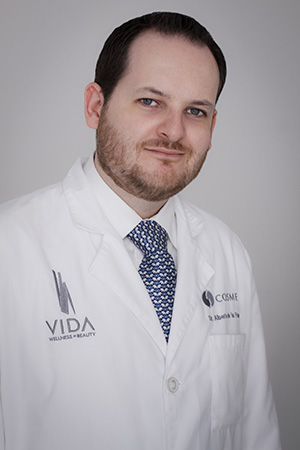

Meet Dr. Alberto De La Fuente, he is our board-certified Dermatologist practicing at VIDA Wellness and Beauty in Tijuana. He specializes in Cosmetic Dermatology, Laser treatment & Non-invasive procedures, Medical Dermatology and Surgical Dermatology. He is a member of the Mexican Academy of Dermatology, Mexican Board of Dermatology, Educational Commission for Foreign Medical Graduates, American Academy of Dermatology.
Learn more about Dr. Alberto De La Fuente, here.

